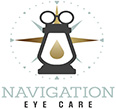Screen and Blink: Managing Digital Eye Strain to Alleviate Dry Eye Symptoms
In the digital age, our screens have become our constant companions. Whether for work, entertainment, or staying connected, we spend hours each day staring at screens. While this connectivity has its benefits, it also brings along a common discomfort – digital eye strain. For many, this discomfort can escalate into dry eye symptoms. If you’re in Chesapeake, VA, learning how to manage digital eye strain with the guidance of Navigation Eye Care’s experienced Optometrist Chesapeake VA can be the key to finding relief.
Understanding Digital Eye Strain and Dry Eyes
Digital eye strain, also known as computer vision syndrome, refers to the discomfort experienced after extended screen time. Symptoms can include dryness, itching, burning, blurred vision, and headaches. Prolonged screen exposure can lead to reduced blink rates, which in turn affects tear distribution and leads to dry eyes.
The Role of Blinking
Blinking might seem like a simple and involuntary action, but it plays a vital role in maintaining healthy eyes. Each blink spreads a thin layer of tears across the surface of the eye, ensuring moisture and preventing dryness. However, when we’re engrossed in screens, our blink rate decreases significantly, leading to inadequate tear distribution.
Managing Digital Eye Strain for Alleviating Dry Eyes
Effectively managing digital eye strain can help alleviate dry eye symptoms. Here’s how:
1. The 20-20-20 Rule:
Every 20 minutes, take a 20-second break and focus on something at least 20 feet away. This rule gives your eyes a chance to relax and blink naturally, preventing the onset of dryness.
2. Blink Regularly:
Consciously remind yourself to blink more frequently while using screens. You can set reminders or practice mindful blinking to ensure your eyes stay moist.
3. Adjust Screen Settings:
Optimize your screen settings for reduced strain. Adjust brightness, contrast, and font size to make viewing more comfortable.
4. Proper Lighting:
Ensure adequate lighting in the room to reduce glare and minimize strain on your eyes.
5. Follow the 15-Degree Rule:
Position your screen around 15 degrees below eye level and at a distance of about 20-28 inches from your eyes. This ergonomic setup encourages a more natural blink rate.
Consulting an Optometrist for Professional Guidance
While self-care strategies are valuable, consulting Navigation Eye Care’s experienced Optometrist Chesapeake VA is essential, especially if your symptoms persist or worsen. An eye doctor can provide personalized guidance based on your unique needs.
The Connection Between Screen Time and Dry Eyes
Understanding the link between screen time and dry eyes is crucial. The more aware you are of how extended screen exposure affects your blink rate and tear distribution, the better equipped you’ll be to manage and prevent digital eye strain.
Taking a Holistic Approach
Managing digital eye strain is more than just preventing dry eyes – it’s about maintaining overall eye health. By adopting healthy screen habits and practicing regular blinking, you’re not only addressing discomfort but also ensuring the long-term well-being of your eyes.
Remember, while these self-care strategies are valuable, seeking professional guidance is essential for long-term eye health. If you’re in Chesapeake, VA, consider reaching out to Navigation Eye Care’s reputable Optometrist Chesapeake VA. With their expertise, you can navigate the digital landscape while ensuring your eyes remain comfortable, moist, and healthy. So, keep your screen time in check, prioritize blinking, and enjoy the benefits of screen without the discomfort of dry eyes.
Environmental Allies: How Diet and Hydration Impact Dry Eye Management
Managing dry eyes goes beyond using artificial tears or adjusting screen habits. While these strategies are valuable, the role of diet and hydration in alleviating dry eye symptoms is often underestimated. A comprehensive approach to dry eye management involves considering the impact of your diet and hydration levels. If you’re seeking relief in Chesapeake, VA, the expertise Navigation Eye Care’s Optometrist Chesapeake VA can guide you toward optimizing your diet and hydration for healthier eyes.
Understanding the Diet-Hydration Connection
The saying “you are what you eat” holds true for your eyes as well. What you consume can directly impact the health and comfort of your eyes. Adequate hydration is equally crucial, as it affects the overall moisture balance in your body, including your eyes.
Incorporating Eye-Friendly Nutrients
Certain nutrients play a significant role in maintaining eye health and preventing dry eyes. Consider incorporating the following into your diet:
1. Omega-3 Fatty Acids:
Found in fatty fish like salmon, walnuts, and flaxseeds, omega-3 fatty acids are known for their anti-inflammatory properties. They can help reduce eye inflammation and support tear production.
2. Vitamin A:
Vitamin A is essential for maintaining the health of the surface tissues of the eyes. Foods rich in vitamin A include carrots, sweet potatoes, and dark leafy greens.
3. Vitamin C:
Vitamin C supports the blood vessels in the eyes and has antioxidant properties. Citrus fruits, strawberries, and bell peppers are excellent sources of vitamin C.
4. Vitamin E:
Vitamin E contributes to overall eye health and can be found in nuts, seeds, and vegetable oils.
Hydration: A Key Factor
Adequate hydration is not only about drinking enough water; it’s also about consuming hydrating foods. Dehydration can lead to reduced tear production, exacerbating dry eye symptoms.
Limiting Dehydrating Foods and Beverages
Certain foods and beverages can contribute to dehydration and worsen dry eyes. These include:
- Caffeinated Drinks: Excessive coffee or caffeinated beverages can lead to increased water loss.
- Sugary Snacks: High-sugar foods can disrupt your body’s hydration balance.
Optimizing Your Diet for Dry Eye Management
Incorporating eye-friendly nutrients and staying hydrated can significantly impact dry eye management. Here’s how to optimize your diet for healthier eyes:
1. Plan Balanced Meals:
Include a variety of nutrient-rich foods in your meals. Aim for a colorful plate filled with fruits, vegetables, whole grains, lean proteins, and healthy fats.
2. Snack Smartly:
Choose hydrating snacks like fresh fruits, vegetables, and nuts to maintain hydration throughout the day.
3. Stay Hydrated:
Drink water consistently throughout the day. Carry a reusable water bottle with you to remind yourself to stay hydrated.
Consulting an Optometrist for Personalized Guidance
While adjusting your diet and hydration habits can have a positive impact on dry eye management, it’s essential to consult Navigation Eye Care’s experienced Optometrist Chesapeake VA. She can assess your specific situation and provide recommendations tailored to your needs.
The Holistic Approach to Dry Eye Management
Managing dry eyes requires a holistic approach that encompasses various factors, including diet, hydration, screen habits, and environmental adjustments.
Embracing Healthy Habits for Brighter Eyes
Optimizing your diet and staying adequately hydrated are simple yet powerful steps toward alleviating dry eye symptoms. By nurturing your body with eye-friendly nutrients and maintaining hydration, you’re not only supporting your eye health but also enhancing your overall well-being.
For personalized guidance on optimizing your diet and hydration for dry eye management, consider connecting with Navigation Eye Care’s Optometrist Chesapeake VA. With their expertise, you can make informed choices that support your eye health and lead to brighter, more comfortable eyes. Remember, by nourishing your body, you’re also nurturing your eyes and embracing a holistic approach to well-being.

